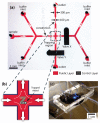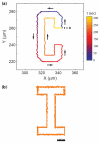Manipulation and confinement of single particles using fluid flow
- PMID: 23682823
- PMCID: PMC3689313
- DOI: 10.1021/nl4008437
Manipulation and confinement of single particles using fluid flow
Abstract
High precision control of micro- and nanoscale objects in aqueous media is an essential technology for nanoscience and engineering. Existing methods for particle trapping primarily depend on optical, magnetic, electrokinetic, and acoustic fields. In this work, we report a new hydrodynamic flow based approach that allows for fine-scale manipulation and positioning of single micro- and nanoscale particles using automated fluid flow. As a proof-of-concept, we demonstrate trapping and two-dimensional (2D) manipulation of 500 nm and 2.2 μm diameter particles with a positioning precision as small as 180 nm during confinement. By adjusting a single flow parameter, we further show that the shape of the effective trap potential can be efficiently controlled. Finally, we demonstrate two distinct features of the flow-based trapping method, including isolation of a single particle from a crowded particle solution and active control over the surrounding medium of a trapped object. The 2D flow-based trapping method described here further expands the micro/nanomanipulation toolbox for small particles and holds strong promise for applications in biology, chemistry, and materials research.
Figures







Similar articles
-
A microfluidic-based hydrodynamic trap for single particles.J Vis Exp. 2011 Jan 21;(47):2517. doi: 10.3791/2517. J Vis Exp. 2011. PMID: 21304467 Free PMC article.
-
A microfluidic-based hydrodynamic trap: design and implementation.Lab Chip. 2011 May 21;11(10):1786-94. doi: 10.1039/c0lc00709a. Epub 2011 Apr 8. Lab Chip. 2011. PMID: 21479293
-
High throughput single-cell and multiple-cell micro-encapsulation.J Vis Exp. 2012 Jun 15;(64):e4096. doi: 10.3791/4096. J Vis Exp. 2012. PMID: 22733254 Free PMC article.
-
Acoustofluidics 20: applications in acoustic trapping.Lab Chip. 2012 Nov 21;12(22):4667-76. doi: 10.1039/c2lc40999b. Lab Chip. 2012. PMID: 23047553 Review.
-
Recent advances in direct current electrokinetic manipulation of particles for microfluidic applications.Electrophoresis. 2019 Sep;40(18-19):2484-2513. doi: 10.1002/elps.201900048. Epub 2019 Mar 8. Electrophoresis. 2019. PMID: 30816561 Review.
Cited by
-
Interfacial Tension Measurements in Microfluidic Quasi-Static Extensional Flows.Micromachines (Basel). 2021 Mar 6;12(3):272. doi: 10.3390/mi12030272. Micromachines (Basel). 2021. PMID: 33800831 Free PMC article.
-
A versatile cancer cell trapping and 1D migration assay in a microfluidic device.Biomicrofluidics. 2019 Jul 23;13(4):044105. doi: 10.1063/1.5103269. eCollection 2019 Jul. Biomicrofluidics. 2019. PMID: 31372193 Free PMC article.
-
Capillary wave tweezer.Sci Rep. 2024 May 30;14(1):12448. doi: 10.1038/s41598-024-63154-0. Sci Rep. 2024. PMID: 38816398 Free PMC article.
-
Stretching DNA to twice the normal length with single-molecule hydrodynamic trapping.Lab Chip. 2020 May 19;20(10):1780-1791. doi: 10.1039/c9lc01028a. Lab Chip. 2020. PMID: 32301470 Free PMC article.
-
Label-free detection and manipulation of single biological nanoparticles.Wiley Interdiscip Rev Nanomed Nanobiotechnol. 2016 Sep;8(5):717-29. doi: 10.1002/wnan.1392. Epub 2016 Feb 5. Wiley Interdiscip Rev Nanomed Nanobiotechnol. 2016. PMID: 26846164 Free PMC article. Review.
References
-
- Johann RM. Analytical and Bioanalytical Chemistry. 2006;385(3):408–412. - PubMed
-
- Nilsson J, Evander M, Hammarstrom B, Laurell T. Analytica Chimica Acta. 2009;649(2):141–157. - PubMed
-
- Yi CQ, Li CW, Ji SL, Yang MS. Analytica Chimica Acta. 2006;560(1–2):1–23.
-
- Grier DG. Nature. 2003;424(6950):810–816. - PubMed
Publication types
MeSH terms
Grants and funding
LinkOut - more resources
Full Text Sources
Other Literature Sources
Research Materials

